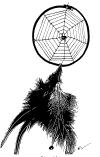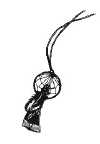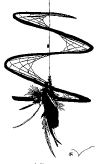Light Burning
Indians living in the forests of North America depended on
forests for their survival. They made canoes, bows and arrows, containers,
spoons, bowls, traps, pipestems, and tools out of wood. The forests provided
game for food, and Indians used wood to build and heat their homes.
Over hundreds of years, Woodland Indians developed a
sophisticated method of forestry to protect their most valuable resource.
They employed a technique called "light burning," which involved setting
small, strategic fires in forests. This cleared the woodland of brush and
weak trees, and created open park-like areas with new growth that attracted
game and prevented the forest from random lightening strikes. The strong
trees survived and grew large and tall, making them ideal for homes and
canoes.
In the late nineteenth century, the beautiful pine forests
in northern Minnesota that had resulted from this kind of light burning
attracted lumber barons. These men, knowing how valuable the trees would be
if they were transformed into lumber and paper, convinced government
officials to push Indians from their lands. The lumber barons then proceeded
to cut down most of the trees in the great forests. Sawmills, railroads and
roads were constructed to process and transport timber, factories were
built, and new towns sprang up to house employees.
The lumber-hungry men had no understanding of forest
conservation, or of how they had destroyed the lives of Ojibwe Indians and
forest animals. Their carelessness and greed had disastrous consequences.
Years of uncleared brush prevented rain from reaching the
roots of trees still standing in the forests, and dry, discarded timber was
piled everywhere in northern Minnesota. The land became a tinderbox waiting
to be ignited. From about 1870 to 1918, huge forest fires called
"firestorms" exploded like bombs and raged throughout the Great Lakes area.
The Great Hinckley Fire was only one of approximately 60
fires which burned out of control in the region. The fire at Hinckley killed
418 people and burned 320,000 acres. Firestorms continued mercilessly until
the government learned better fire-fighting techniques and returned to some
native forestry practices.
Today, modern firefighters realize the
importance of light burning, but they are unable to use it effectively
because of the large numbers of people who have homes and businesses on
forest land. These firefighters recognized and now envy the forestry
management methods used by Ojibwe and other Woodland Indians, which have
never been duplicated.

Ricing
Ricing is a seasonal ritual that connects Ojibwe Indians
to their ancestral traditions.
The Ojibwe People originally lived on the shores of the
Atlantic Ocean. Many of these People migrated west, and about 500 years ago,
settled in areas that became Minnesota, Wisconsin, Michigan and Canada —
"the land where food grows on the water."
 Mahnomen,
or wild rice, is the food that grows on the water, and it is still
harvested by Mille Lacs Band members in August and September. Gathering rice
in the traditional manner usually involves two people who go out in a canoe.
One poles the craft, and the other sweeps wild rice stalks over the canoe
and knocks the grains into the bottom of the canoe with ricing sticks.
Mahnomen,
or wild rice, is the food that grows on the water, and it is still
harvested by Mille Lacs Band members in August and September. Gathering rice
in the traditional manner usually involves two people who go out in a canoe.
One poles the craft, and the other sweeps wild rice stalks over the canoe
and knocks the grains into the bottom of the canoe with ricing sticks.
Using an age-old process, the wild rice is placed in a
huge iron pot over a fire and parched. The rice is then jigged and thrashed
by the clean, moccasined feet of boys and men, or girls who are not yet
women. After the rice is dried, it is winnowed — tossed into the air with a
winnowing basket to separate the husks from the grains — and stored in
wiigwaas mukkaks or birchbark containers. Because wiigwaas are crafted
individually, these containers often become collectors’ items.
Rice harvested in this manner is considered a gourmet
treat and is sometimes sold in specialty stores. The flavor and appearance
of this rice is much better than commercial wild rice.
White Eagle Soaring: Dream Dancer of the 7th Fire








 Get
a course to promote your business online, explode your sales
Get
a course to promote your business online, explode your sales Get
software to promote your business online in less time
Get
software to promote your business online in less time Get
software to streamline your business and run it hands free.
Get
software to streamline your business and run it hands free.

 Mahnomen,
or wild rice, is the food that grows on the water, and it is still
harvested by Mille Lacs Band members in August and September. Gathering rice
in the traditional manner usually involves two people who go out in a canoe.
One poles the craft, and the other sweeps wild rice stalks over the canoe
and knocks the grains into the bottom of the canoe with ricing sticks.
Mahnomen,
or wild rice, is the food that grows on the water, and it is still
harvested by Mille Lacs Band members in August and September. Gathering rice
in the traditional manner usually involves two people who go out in a canoe.
One poles the craft, and the other sweeps wild rice stalks over the canoe
and knocks the grains into the bottom of the canoe with ricing sticks.
